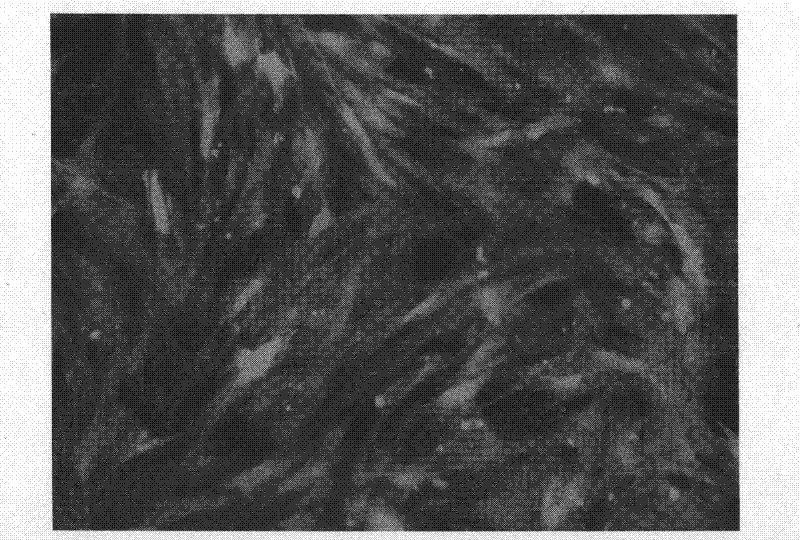Construction method and application of piggyBac transposon vector for producing transgenic goat
A technology of transgenic goat, construction method, applied in the field of gene carrier
- Summary
- Abstract
- Description
- Claims
- Application Information
AI Technical Summary
Problems solved by technology
Method used
Image
Examples
Embodiment 1
[0037] Example 1: Construction of pBluSKm-PB vector
[0038] Synthesize a segment of PB5' and PB3' base sequences necessary for the transposition of piggyBac transposon, and design and add BglII, NheI, SalI, ClaI, MluI restriction sites between the PB5' and PB3' ends At the same time, a KpnI restriction site was added at the beginning of PB5', and a SacII restriction site was added at the end of PB3', and then the sequence was cloned into the vector pBluSKm to construct the pBluSKm-PB vector.
[0039] The specific sequence is as follows:
[0040] CCCCCC CCCTAGAAAGATAGTCTGCGTAAAATTGACGCATGCATTCTTGAAATATTGCTCTCTCTTTCTAAATAGCGCGAATCCGTCGCTGTGCATTTAGGACAT C TCAGTCGCCGCTTGGAGCTCCCGTGAGGCGTGCTTGTCAATGCGGTAAGTGTCACTGATTTTGAACTATAACGACCGCGTGAGTCAAACGATGACGCATG AT TATCTTTTACGTGACTTTTAAGATTTAACTCATACGATAATTATATTGTTATTTATGTTATTATTCATTGTTATTCATTTATTATT
Embodiment 2
[0041] Example 2: Construction of pBluSKm-PB-PRD vector
[0042] Using goat genomic DNA as a template, the rumen-specific expression promoter PRD-SPRR II primer was designed with reference to the sequence of PRD-SPPRII (accession number: AF279613.1) reported in GenBank, and BamHI and NheI restriction sites were placed on both ends of the primer, The primer sequences are:
[0043] PRD-SPRR II-F TGATTTAAATTAACTTGG
[0044] PRD-SPRR II-R ATGGTGAGGCATCCTTCCTG
[0045] The promoter sequence was amplified by PCR in a 25 μl reaction system. The reaction conditions were pre-denaturation at 95°C for 5 min, 95°C / 30sec, 58°C / 30sec, and 72°C / 3min for 35 cycles, followed by 10min extension at 72°C. The PCR products were double digested with BamHI and NheI, respectively, and the pBluSKm-PB plasmid was double digested with BglII and NheI, respectively. The digested products were recovered and ligated with T4 DNA ligase to construct the pBluSKm-PB-PRD vector.
Embodiment 3
[0046] Example 3: Construction of pBluSKm-PB-PRD-cysEM vector
[0047] Based on the cysE and cysM sequences reported by GenBank (accession number: CP000819), the cysE and cysM sequences were optimized for codon preference (cash goat), and the ribosome binding site IRES sequence was added between the optimized cysE and cysM sequences. , add BGH pola sequence at the end of the optimized cysM sequence, and finally synthesize the sequence. NheI and SalI restriction sites were added to the beginning and end of the synthetic gene sequence, respectively. The synthetic gene cysE-IRES-cysM and pBluSKm-PB-PRD plasmids were digested with NheI and SalI respectively, and the digested products were recovered and ligated with T4 DNA ligase to construct pBluSKm-PB-PRD-cysEM vector.
PUM
 Login to View More
Login to View More Abstract
Description
Claims
Application Information
 Login to View More
Login to View More - R&D
- Intellectual Property
- Life Sciences
- Materials
- Tech Scout
- Unparalleled Data Quality
- Higher Quality Content
- 60% Fewer Hallucinations
Browse by: Latest US Patents, China's latest patents, Technical Efficacy Thesaurus, Application Domain, Technology Topic, Popular Technical Reports.
© 2025 PatSnap. All rights reserved.Legal|Privacy policy|Modern Slavery Act Transparency Statement|Sitemap|About US| Contact US: help@patsnap.com



